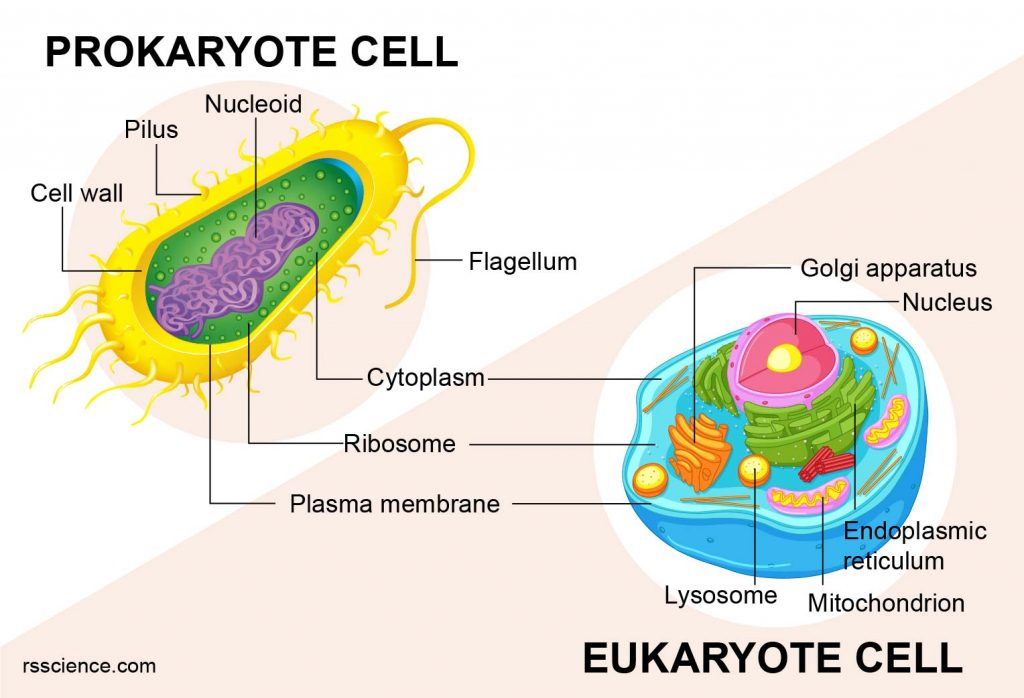All living things are made of cells—the fundamental units of life. Whether an organism is made of just one cell (unicellular) or many(multicellular), it belongs to one of two main groups: prokaryotes or eukaryotes. This classification is based on the structure of their cells. In this article, we will show you what prokaryotes and eukaryotes are and outline the similarities and differences between the two.

[In this figure] Tree of living organisms showing the origins of eukaryotes and prokaryotes.
Photo source: wiki.
This article covers
Definition: What is a prokaryote?
Prokaryotes (pro-KAR-ee-ot-es) are unicellular organisms that don’t have a membrane-bound nucleus and other organelles. Prokaryotic cells tend to be small, simple cells, measuring around 0.1-5 μm in diameter. Bacteria and archaea are two major branches of prokaryotes.
The name “prokaryote” comes from the Old Greek: pro- = before; karyon = nut or kernel, referring to the cell nucleus; suffix -otos, pl. -otes).

[In this figure] Diagram of a bacterium.
The key structures in a prokaryote cell are shown.
Prokaryotic cell structure
While prokaryotic cells do not have membrane-bound organelles, they do have distinct cellular structures. Below is a breakdown of what you might find in a prokaryotic bacterial cell.
| Cell feature | Function |
| Nucleoid | A central region of the cell contains its DNA. |
| Plasmid | A small circular piece of DNA that is physically separated from chromosomal DNA. |
| Cytoplasm | Cellular fluid hosting all other cellular structures. |
| Cell membrane | Also known as the plasma membrane, that separates the cell from the outside environment. |
| Cell wall | Provides structure and protection from the outside environment. Most bacteria have a rigid cell wall made from carbohydrates and proteins called peptidoglycans. |
| Capsule | Some bacteria have a layer of carbohydrates that surrounds the cell wall called the capsule or glycocalyx. The capsule helps the bacterium attach to surfaces. |
| Ribosome | The site for protein synthesis. |
| Cytoplasmic inclusion | Inclusion bodies like ribosomes and larger masses scattered in the cytoplasm. |
| Pilus | Hair-like structures that help with cellular attachment and DNA transfer. |
| Flagellum | Tail-like structures that assist in the movement |
Examples of prokaryotes
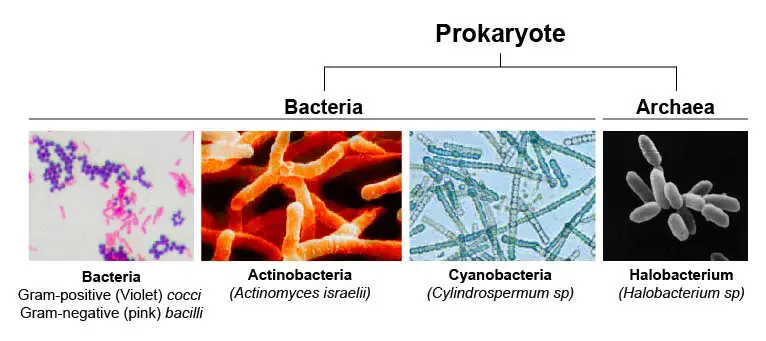
[In this figure] Prokaryotic cells comprise bacteria and archaea. They typically have a diameter of 0.1–5 μm, and their DNA is not contained within a nucleus. Instead, their DNA is circular and can be found in a nucleoid region, which floats in the cytoplasm. Cyanobacteria, also known as “blue-green algae,” are prokaryotes consisting of photosynthetic bacteria.
Photo source: wiki.
Definition: What is an eukaryote?
The name “Eukaryote” literally means to possess a “true nucleus.” Eukaryotes are organisms whose cells have a membrane-enclosed nucleus and other organelles. These membranes are similar to the cell membrane, which is a flexible film of lipid bilayers. Organelles are internal structures responsible for a variety of functions, such as energy production and protein synthesis.
Eukaryotic cells are relatively larger (around 10-200 μm) and more complex. Eukaryotic cells can be free-living as single-cell microorganisms (like paramecium and amoeba) or become parts of multicellular organisms.
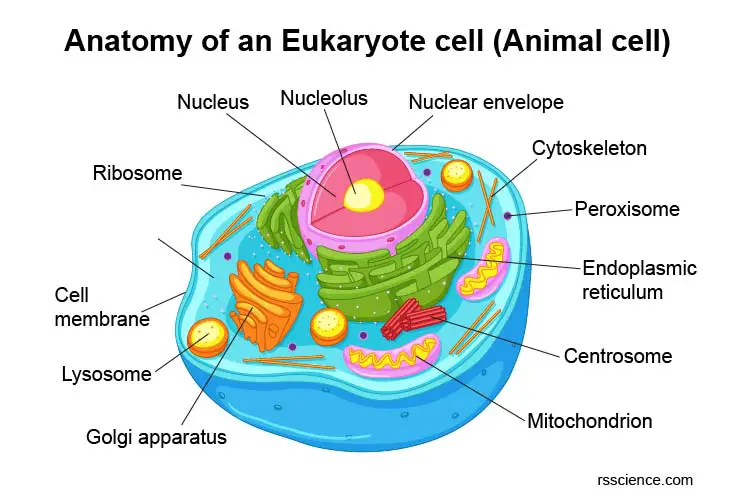
[In this figure] Diagram of an animal cell.
The key structures in a eukaryote cell are shown.
Eukaryotic cell structure
An organelle is a tiny cellular structure that performs specific functions within a cell. You can think of organelles as a cell’s internal organs. For example, the nucleus is the cell’s brain, and the mitochondria are the cell’s heart. Organelles are often enclosed by their own membranes, which divide the cell into many small compartments for different biochemical reactions. Below is an overview of the primary components of eukaryotic cells.
| Cell feature | Function | Membrane-bound organelle (Yes or No) | Present in Eukaryote (E) or Prokaryote (P) |
| Nucleus | A central place to store the genetic information (genome) of the cell. | Y | E |
| Nucleolus | A core inside the eukaryotic nucleus where ribosomal RNA is produced. | N | E |
| Nuclear envelope | The membrane separates the nucleus and cytoplasm. | Y | E |
| Cytoplasm | The part of the cell between the nuclear envelope and plasma membrane. | N | E, P |
| Cytosol | Gel-like cellular fluid filled up the intracellular space. | N | E, P |
| Cell membrane | Also known as the plasma membrane, a phospholipid bilayer that surrounds the entire cell and encompasses the organelles within. | Y | E, P |
| Cell wall | Provides structure and protection from the outside environment, only in plants and fungi. | N | E, P |
| Vacuole | A membrane-bound organelle that contains a mass of fluid and functions as a storage space. A large central vacuole only exists in plant cells. | Y | E |
| Chloroplast | An organelle that conducts photosynthesis and produces energy for the plant cells. | Y | E |
| Cytoskeleton | A dynamic network for cell movement, division, and intracellular transportation. | N | E, P |
| Mitochondrion | Also known as the powerhouse of the cell, responsible for energy production. | Y | E |
| Ribosome | The site for protein synthesis. | N | E, P |
| Endoplasmic reticulum | An internal membrane that forms branching networks and coordinates protein synthesis. | Y | E |
| Golgi apparatus | A membrane-bounded organelle dedicated to protein maturation and transportation. | Y | E |
| Lysosomes | An organelle full of digestive enzymes and works like a recycling center in the cell. | Y | E |
| Peroxisome | An organelle responsible for the fatty acid breakdown and other redox reactions. | Y | E |
Examples of eukaryotes
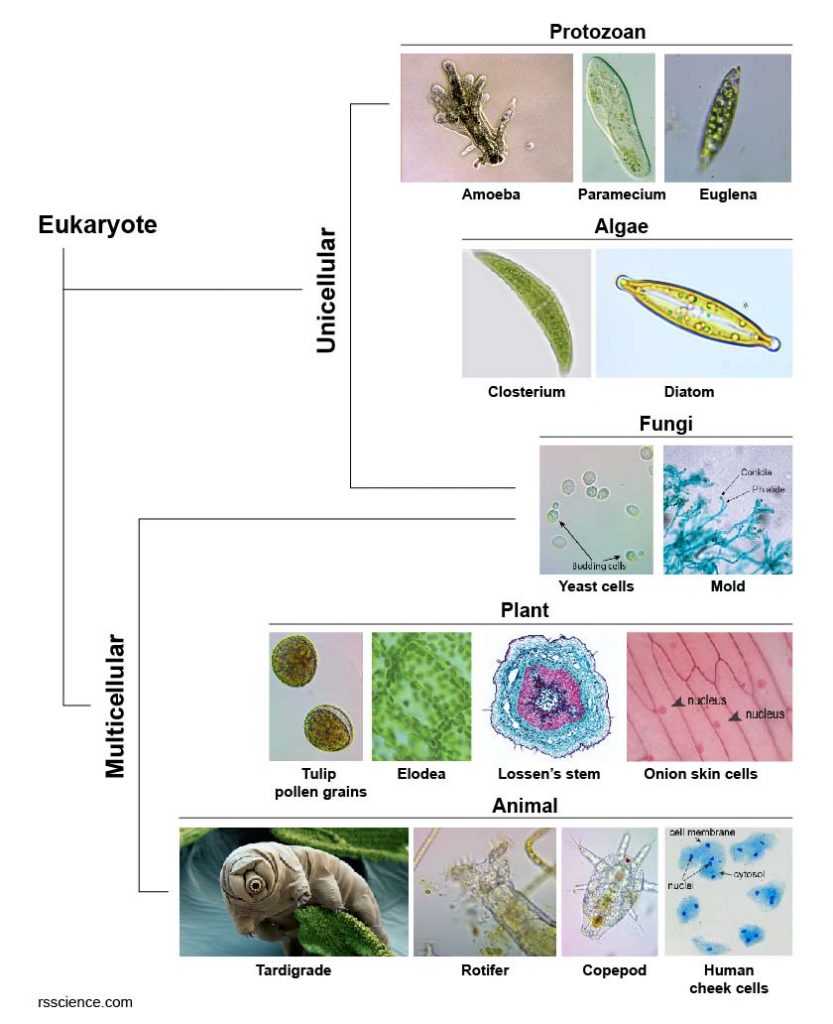
[In this figure] Animals, plants, fungi, algae, and protozoans are all eukaryotes.
Most animals and plants are multicellular organisms, while algae and protozoans are unicellular. Fungi consist of both unicellular (yeasts) and multicellular (molds and mushrooms) organisms.
Prokaryotes vs. Eukaryotes – key similarities
I. Both prokaryotic and eukaryotic cells follow the “Cell theory”
In biology, cell theory is the historic scientific theory, now universally accepted. The three principles of the cell theory are as described below:
- All living organisms are composed of one or more cells.
- The cell is the basic unit of structure and function in organisms.
- Cells arise from pre-existing cells.
Both prokaryotic and eukaryotic cells meet the description of cell therapy. On the other hand, “viruses” – tiny structures that can only reproduce inside host cells- are not generally considered living cells.
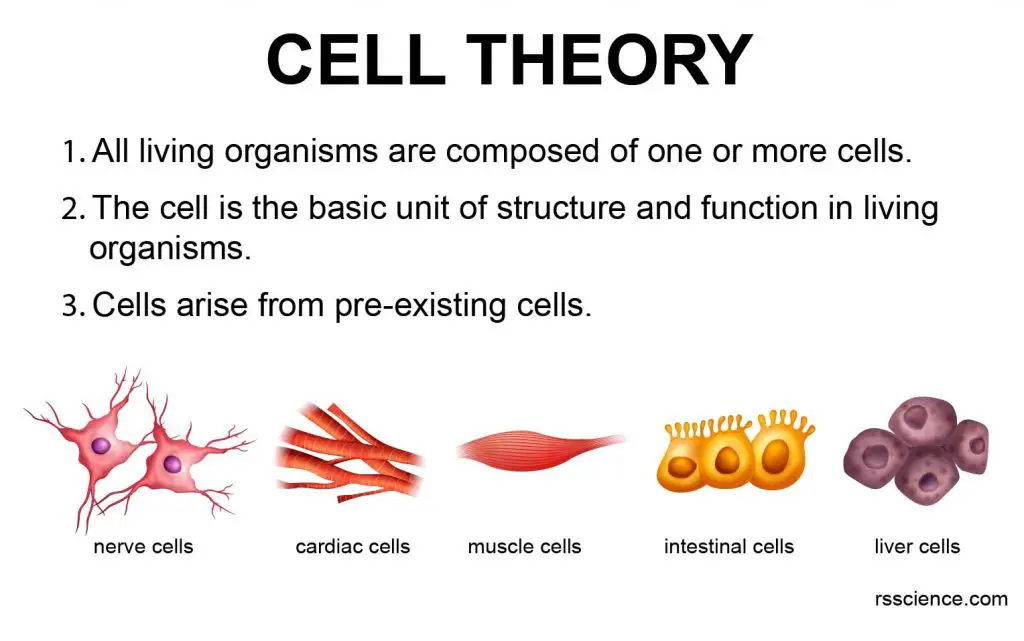
II. Both prokaryotic and eukaryotic cells have similar chemical compositions
Prokaryotic and eukaryotic cells differ structurally in many ways. However, it’s important to note that the chemical compositions of these cellular structures and organelles are the same.
For example, both types of cells use and/or contain:
- Carbohydrates
- Lipids
- Proteins (long chains of amino acids)
- DNA and RNA (long chains of nucleic acids)

[In this figure] The composition of a bacterial cell.
Most of a cell is water (70%). The remaining 30% contains various proportions of structural and functional molecules.
Photo source: Scitable by nature education.
III. Both prokaryotic and eukaryotic cells share similarities in biochemical reactions that are fundamental to all lives
The biomolecules and biochemical reactions that enable cell life are common in both life forms. All types of cells must make and store energy to survive. Whether a cell is autotrophic or heterotrophic, it needs energy to maintain its structure and carry out a range of functions that include cell replication. For example, both cells use adenosine triphosphate (ATP) as the “molecular unit of currency” to provide energy.
IV. Both prokaryotic and eukaryotic cells obey the central dogma of molecular biology
The central dogma of molecular biology explains the flow of genetic information within a biological system. It is often stated that “DNA makes RNA, and RNA makes protein.”
The same system was conserved from prokaryotes to eukaryotes. Both use DNA polymerases to replicate DNA, RNA polymerases for mRNA transcription, and ribosomes for protein translation.
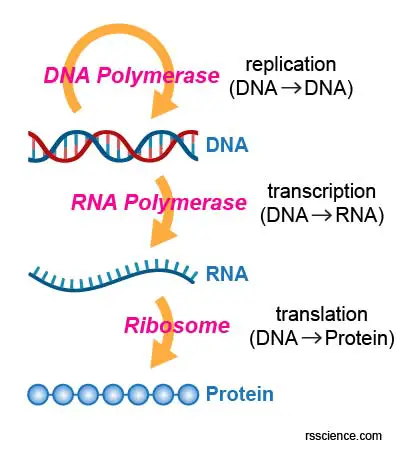
[In this figure] An overview of the central dogma of molecular biochemistry.
V. Similar cell structures in both prokaryotic and eukaryotic cells
All cells, whether prokaryotic or eukaryotic, share these four features:
- Chromosomal DNA
- Plasma membrane
- Cytoplasm
- Ribosomes
Prokaryotes vs. Eukaryotes – major differences
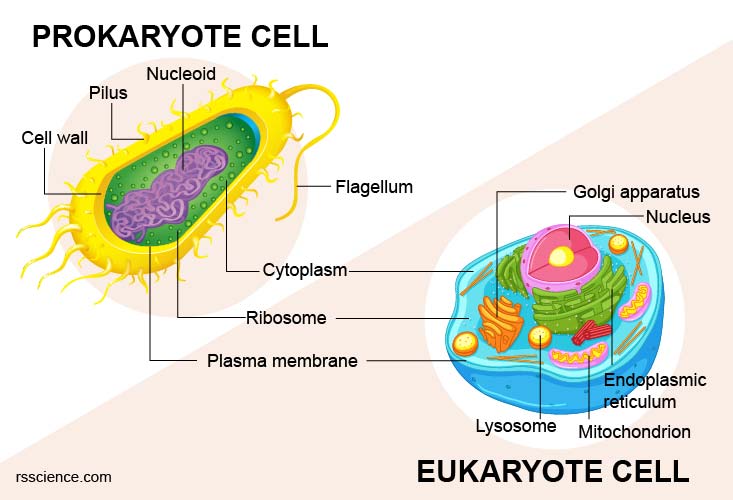
[In this figure] The differences and similarities of eukaryotic and prokaryotic cell structures.
The most striking difference between prokaryotes and eukaryotes is that membrane-bound nucleus only exists in eukaryotic cells. Other than that, we summarize the major differences in this table.
| Characteristics | Eukaryotic cells | Prokaryotic cells |
| Definition | Cells that contain a clearly defined nucleus | Cells that don’t have a membrane-bound nucleus |
| Examples | Animals, plants, fungi, algae, and protists | Bacteria and archaea |
| Cell size | Large (10-200 μm) | Small (less than 1-5 μm) |
| Organism type | Both uni- and multi-cellular | Only unicellular |
| Nucleus | Present (membrane-bound) | Absent (only nucleoid region) |
| DNA | Linear DNA bound to proteins | Circular, naked DNA |
| DNA replication | Highly regulated with selective origins and sequences | Replicates entire genome at once |
| Chromosome | More than one; chromosomes paired (diploid or more) | One single loop of chromosomal DNA (haploid) and several small, independent plasmids; |
| Intron | Usually has introns | Usually, no introns |
| Genome | Contains large amount of noncoding and repetitive DNA | Efficient and compact, containing little repetitive DNA |
| Organelles | Has membrane-bound organelles | No membrane-bound organelles |
| Ribosome | Large; 80S ribosomes | Small; 70S ribosomes |
| Plasma membrane | Present | Present |
| Cytoplasm | Present | Present |
| Cytoskeleton | Present | May be present |
| Mitochondria | Present | Absent |
| Chloroplasts | Present in plants | Absent |
| Cell wall | Simple; present in plants and fungi | Complex; present in all prokaryotic cells |
| Reproduction | Mitosis and meiosis | Binary fission |
| Growth rate | Slower | Faster |
| Ability to store hereditary information | Yes | Yes |
| Transcription and translation | Separated; transcription occurs in the nucleus and translation in the cytoplasm | Coupled, meaning translation begins during mRNA synthesis (transcription) |
From prokaryotes to eukaryotes: endosymbiosis and eukaryotic cell evolution
The hypothesis that eukaryotic cells evolved from a symbiotic association of prokaryotes is particularly well supported by studies of mitochondria and chloroplasts, which are thought to have evolved from bacteria living in large cells. This is called “endosymbiosis theory.”
Around 1.5 billion years ago, some prokaryotic cells engulfed other prokaryotes into their cells. These engulfed cells were not digested; instead, they stayed in a symbiotic relationship. These incorporated prokaryotes then lost their ability to live independently and became integrated as part of the hosts. They later became specialized in specific functions, such as energy production in both mitochondria and chloroplasts. The host cell provides physical protection and a constant supply of food and oxygen in return.
Mitochondria appear to be related to Rickettsiales proteobacteria, and chloroplasts appear to be related to nitrogen-fixing filamentous cyanobacteria. Both mitochondria and chloroplasts still keep their own DNA to make some of their proteins, but most of their proteins still require nuclear DNA from the host cells. The double layers of mitochondrial membranes are another evidence of endosymbiotic origin. The inner mitochondrial membrane could be the original membrane of the engulfed bacterium. The outer mitochondrial membrane was the remaining vesicle when the host cell incorporated the bacterium.
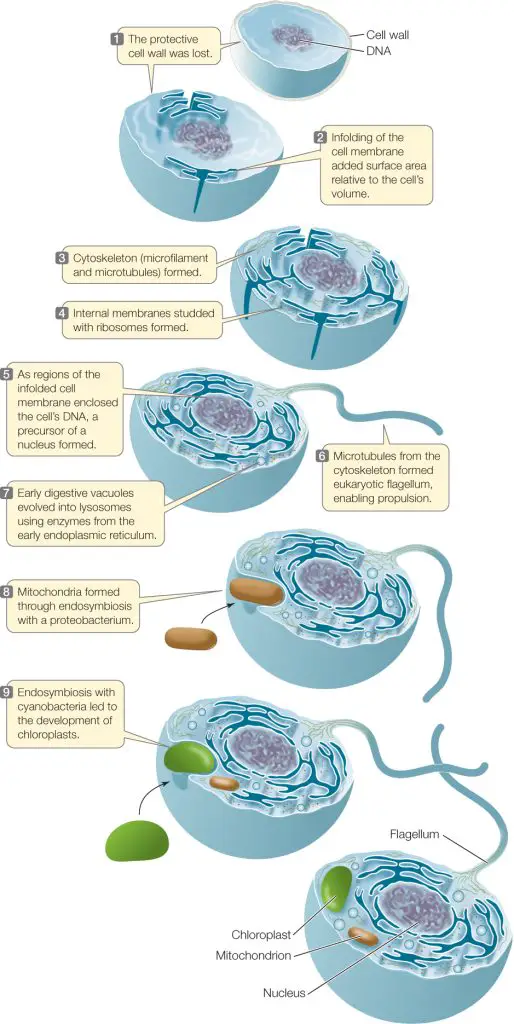
[In this figure] Evolution of the eukaryotic cells.
The loss of a rigid cell wall allowed the cell membrane to fold inward and create more surface area (forming endoplasmic reticulum), which facilitated the evolution of larger cells. As cells grew larger, cytoskeletal complexity increased, and the cell became increasingly compartmentalized. Endosymbiosis involving bacteria gave rise to mitochondria and chloroplasts.
Photo source: macmillan learning.
How do you distinguish eukaryotic and prokaryotic cells under a microscope?
You may roughly tell whether a cell is eukaryotic or prokaryotic by its size. Usually, eukaryotic cells are larger (10-200 µm), and prokaryotic cells are smaller (less than 1-5 µm).
You can also try to identify the conclusive evidence of eukaryotic cells: the nucleus and organelles. In some protists of large cells, some organelles are visible even without staining. For example, food vacuoles and contractile vacuoles are apparent when viewing amoebas and paramecia under a microscope. Microscopic techniques such as darkfield, phase contrast, and DIC can also make organelles, and cellular structures stand out.
The nucleus can be visualized by the staining of its DNA contents by special dyes. Methylene blue is a popular stain for staining animal cells to make nuclei more visible. Methylene blue binds DNA, which is abundant in the nucleus. The nuclei appear in a deep blue color after methylene blue staining. Methylene blue is commonly used by aquarium hobbyists for treating fishes with fungal diseases. You may find useful dyes for microscopic projects at home.
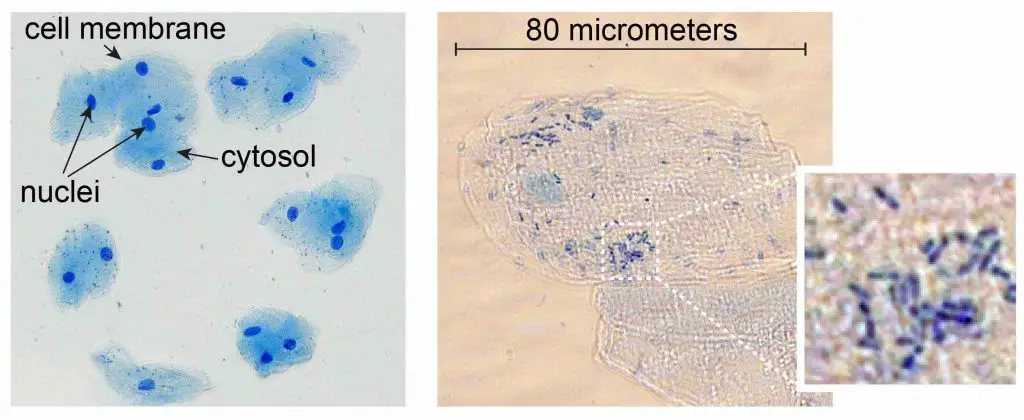
[In this figure] Check cells stained with Methylene Blue.
The left image is at a lower magnification. You can see the nuclei stained with a dark blue (because Methylene Blue stains strongly with DNA). The cell membrane acts like a balloon and holds all the cell parts, like a nucleus, cytosol, and organelles inside. The right image is at a higher magnification. You can also see some small rod-shaped bacteria. Don’t worry; they are normal oral microbes.
You can see our step-by-step guide “Look at your cheek cells. “
For fluorescence microscopy, DNA-binding dyes stain nuclei nicely. Common choices include DAPI (4′,6-diamidino-2-phenylindole), Sybr Green, and Ethidium bromide (EtBr).
Q&A: Some frequently asked questions are quickly answered here
Do prokaryotes (bacteria) have a nucleus?
No, prokaryotes don’t have a membrane-bound nucleus. Their DNA is in a region called nucleoid in the cytoplasm. The lack of a nucleus is the major characteristic that separates prokaryotes from eukaryotes. See “Prokaryotes vs. Eukaryotes – major differences” to learn more.
Do prokaryotes have organelles?
Prokaryotic cells don’t have the same organelles that eukaryotes have. Generally speaking, prokaryotes don’t have any membrane-bound organelles (including a nucleus, mitochondria, chloroplasts, endoplasmic reticulum, Golgi apparatus, lysosome, and peroxisome). However, prokaryotic cells have other organelles or cellular structures, such as cell membrane, cell wall, nucleoid, ribosomes, and flagella. See “prokaryotic cell structure” to learn more.
Do prokaryotes have ribosomes?
Yes, prokaryotes have ribosomes for protein synthesis. Prokaryotic ribosomes are smaller than eukaryotic ribosomes. Since prokaryotes lack a nucleus, their mRNAs are transcribed in the cytoplasm and can be translated by ribosomes immediately. As a result, in a bacterium cell, you can even see several ribosomes attached to a single RNA molecule. See “polysomes” to learn more.
Do prokaryotes (bacteria) have mitochondria?
No, prokaryotes don’t have mitochondria. However, ancient prokaryotes could be the ancestors of mitochondria in current eukaryotic cells. See “endosymbiosis and eukaryotic cell evolution” to learn more.
Do prokaryotes have a cell wall?
Yes, all prokaryotic cells are encased by a cell wall. Many also have a capsule or slime layer made of polysaccharides. However, the composition of prokaryotic cell walls is different from the cell walls in eukaryotic plant cells. See “plant cell wall” to learn more.
Do prokaryotes have DNA?
Yes, both prokaryotic and eukaryotic cells use DNA as their genetic material. Both also follow “the central dogma of molecular biology” as “DNA makes RNA, and RNA makes protein” sustain their living.

